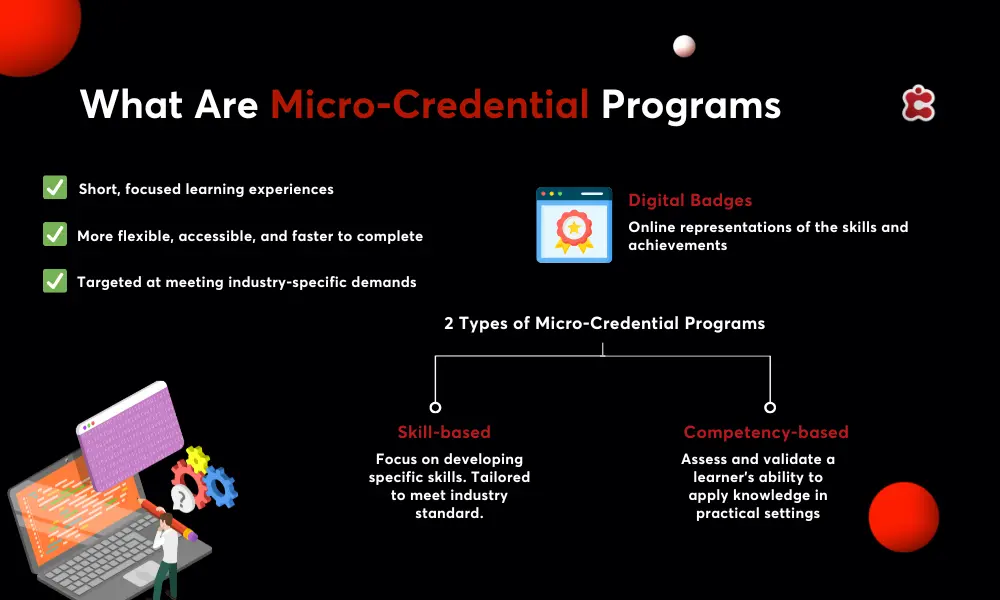The job market today is crazy, to say the least. It feels like every other day, there’s a new skill in demand, and it’s tough for students—and even professionals—to keep up. That’s why micro-credential programs are becoming such a big deal, and honestly, it’s something your college should consider offering.
Micro-credentials are short, focused courses that teach specific, in-demand skills quickly. Think of them as a fast track to staying competitive in a fast-moving world.
So, why should your institution jump on the micro-credential train? For starters, they’re perfect for attracting a diverse range of students. From recent grads to working professionals, there are bite-sized learning options that fit all schedules.
The best part? Running these programs doesn’t have to be complicated. With the right School Management System (SMS), creating, managing, and tracking micro-credentials is a breeze. We’ll show you exactly how to use your SMS to create, run, and provide certifications throughout the entire micro-credential program process. Let’s dive in!

Why Should Colleges Offer Micro-Credential Programs?
If you’re still on the fence about offering micro-credential programs at your college, let’s break down some of the key benefits.
- Expanding Market Reach: Micro-credentials attract a diverse audience, including working professionals, career changers, and lifelong learners, opening your doors to new student demographics.
- Building Partnerships with Industry: By collaborating with employers to develop targeted programs, you can create pathways for students into the workforce, enhancing your institution’s connections and credibility.
- Boosting Institutional Reputation: Offering cutting-edge programs demonstrates your commitment to innovation and relevance, positioning your college as a leader in higher education.
- Increased Revenue Streams: Micro-credential programs can bring in additional revenue without the overhead costs of traditional degree programs, allowing you to invest in other areas of your institution.
- Enhanced Student Engagement: With flexible, bite-sized learning options, students are more likely to stay motivated and engaged, which can lead to higher retention rates and satisfaction.
How School Management Systems Support Micro-Credential Programs
So, why should you use your School Management System to support micro-credential programs? First off, SMS allows administrators to create and manage modular, customizable courses that can be tailored to meet industry demands. This flexibility means you can quickly adapt to changing skills in the job market, ensuring your offerings remain relevant. Plus, with an intuitive interface, setting up these courses is a breeze.
Another significant advantage is how SMS streamlines the onboarding process for students enrolling in these programs. With automated enrollment features, students can easily sign up and access course materials without the hassle of complicated paperwork.
Additionally, managing the awarding of micro-credentials, digital badges, or certificates becomes automated. This level of efficiency and support is crucial in nurturing a culture of success for both students and institutions alike.
Steps to Create a Micro-Credential Program Using SMS
Step 1: Identify Key Skills and Competencies
Start by pinpointing the skills and competencies that align with industry demands. Collaborate with industry partners to design micro-credentials that meet market needs. This ensures your programs are relevant and attractive to prospective students.
Step 2: Build the Curriculum and Courses
Once you’ve identified the focus areas, structure your program into bite-sized, competency-based modules. Use specific SMS features like custom fields, multi-module options for comprehensive learning, and flexible scheduling to accommodate diverse student needs. This modular approach enhances the learning experience and keeps students engaged.
Step 3: Use Assessment and Feedback Tools
Leverage the assessment tools in your SMS to monitor student progress and ensure competencies are being met. Create quizzes and projects that provide real-time performance feedback, allowing students to see their growth and identify areas for improvement.
Step 4: Award Digital Badges and Certifications
Finally, streamline the awarding of credentials by setting up automated certifications through your SMS. Integrate digital badging, enabling students to showcase their achievements on various platforms. This recognition not only enhances their marketability but also fosters a positive learning experience, encouraging them to pursue more micro-credentials in the future.
Evaluating the Success of Micro-Credential Programs
Assessing the success of your micro-credential programs is essential for continuous improvement and ensuring they meet the evolving needs of students and industry partners. Here are some key metrics you can look at:
| Key Metric | Description |
| Completion Rates | Track the percentage of students who complete the micro-credential courses. |
| Enrollment Numbers | Monitor how many students enroll in each program, looking for trends over time. |
| Credentialing Rates | Measure the number of students who earn their micro-credentials compared to those who started the program. |
| Industry Alignment | Evaluate how well the skills taught align with current industry demands by analyzing job placement rates of credential holders. |
| Student Satisfaction | Use surveys to gauge student satisfaction regarding course content, delivery, and overall experience. |
| Employer Engagement | Assess feedback from industry partners about how well graduates meet job requirements and expectations. |
Student and Employer Feedback
For students, consider conducting surveys or focus groups to gather insights on their experiences and suggestions for program improvements. Engaging with employers is equally crucial; solicit their feedback on the effectiveness of the micro-credentials in preparing students for real-world challenges.

Classter’s SMS for Micro-Credential Programs
Imagine having a single platform that not only allows you to design courses but also automates the entire process of awarding micro-credentials, digital badges, or certificates. Sounds pretty great, right? Classter’s SMS makes this a reality, helping you streamline operations while focusing on what truly matters—your students’ success.
With Classter, you can easily create customized learning paths that align with industry needs. Our intuitive interface allows administrators to build bite-sized, competency-based modules tailored to the skills your students need. This flexibility ensures that you’re not just offering courses; you’re providing valuable, market-relevant skills that enhance employability. Plus, you can track student progress in real-time, using built-in assessment tools to ensure each learner is mastering the content before moving forward. The ability to give timely feedback keeps students engaged and motivated, making learning a dynamic experience.
Ready to take your micro-credential programs to the next level? With Classter’s SMS, you can elevate your offerings, enhance student engagement, and position your institution as a leader in innovative education. Let’s make learning meaningful together.
FAQ’s
Micro-credential programs are short, focused courses designed to teach specific, in-demand skills. They offer a flexible and fast way for students or professionals to gain competencies that are immediately applicable in the job market.
An SMS allows institutions to design and manage micro-credential programs efficiently by providing tools for course creation, student enrollment, tracking progress, and awarding digital badges or certificates.
Classter allows administrators to build customizable, competency-based learning paths that can be tailored to industry needs. The platform’s intuitive interface makes course design and management simple.

